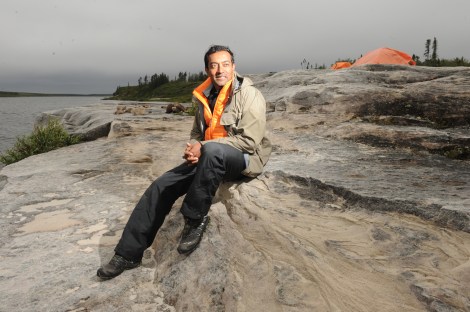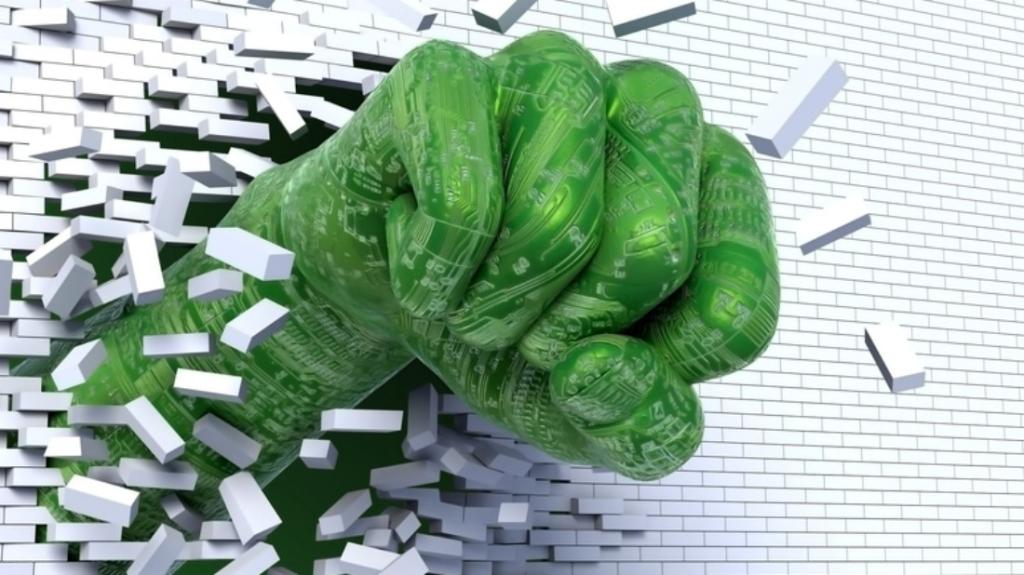If you thought the title of Showtime’s new series, Years of Living Dangerously, was just a reference to the perils of climate change, think again: “I almost died on that show,” one of its hosts, M. Sanjayan, told us when he came into the Grist office earlier this month.
Sanjayan helps tell the story of climate change by journeying to exotic places like the Andes and Christmas Island. But when he’s not swashbuckling around the world in the name of the environment and science, he’s still vouching for it: previously, as the head scientist at the Nature Conservancy, and now as the executive vice president of Conservation International. He also keeps the conversation going through media outlets like the Huffington Post and CBS News.
We talked with Sanjayan about his brush with death, finding the face of climate change (hint: It’s not a polar bear’s), and coming to grips with the fact that, at this point, we’re going to have to adapt to the hot new conditions we’ve created. And, in our lightning round video at the top of the post, we asked him what we really wanted to know: Neil deGrasse Tyson or Bill Nye?
Here’s an edited and condensed version of our conversation.
Q. We wanted to start by asking you about Years of Living Dangerously and any notable, meaningful moments.
A. I almost died on that show. Yeah. I was actually ready to quit pretty early on — literally almost died.
Q. Wow — what happened?
A. They sent me to the Tupungatito glacier in the Andes, on the Chile-Argentine border. It’s a pretty big mountain. And we were going to the top of it and then cresting it and then going into sort of a caldera to look for very old ice, with an ice scientist by the name of Paul Mayewski. He’s a University of Maine professor. The problem is, we were doing this really fast. And so we base-camped at like 10,000 feet and then in a day we went to 20,000. And it’s very steep, it’s very loose, and there were boulders the size of basketballs coming down the mountain.
We started with a crew of 12 people total. Four of them didn’t summit, which gives you an idea. There was a lot of attrition. The main camera guy we brought from New York got deathly ill on day two. He had to be evacuated out. So we flew in by helicopter a Chilean cameraman to replace him. He got kicked in the head by a horse, so he was out. So the [assistant producer] took the camera and started shooting. The director couldn’t get out on the glacier; she was just sort of throwing up. And I was like, “I’m going to die. I literally could die here.”
Q. Science!
A. Exactly. It gave me a real sense that the scientists we were following on the show were going to the ends of the Earth to get data. Quite literally. And they were risking a lot, in very physical terms, to get what they thought was necessary to learn about the future of the planet.
Another journey I did was to Christmas Island, the Pacific atoll, with a woman named Kim Cobb. Kim studies coral because coral grows in a really unique way that’s very tightly linked to temperature. So you can drill into the coral head and figure out what the ocean temperature was very precisely. I can tell you November 1972, this was the temperature. Really amazing. And then she uses fossilized coral to go back 7,000 years.
Kim was probably in her late 30s, a mom of three, and she’s underwater with a giant, 100-pound drill, drilling cores out of coral. There’s one flight in every week from Fiji and Hawaii. That’s it.

M. Sanjayan.
Q. Did you walk away from that project with a different perspective on climate change?
A. Without a doubt. Look, I’ve gotta tell you, I’ve felt a bit like a fake when I’ve gone out and talked about climate, because I only understood it intellectually. I study it. I read the papers. It was an intellectual argument — it wasn’t a story that I could tell. I didn’t feel it in my bones.
I went on Lettermen a few years ago, and he hammered me on climate. He’s really passionate about climate, and he just came at it really hard. And I zigged and zagged and parodied and joked, and kind of got myself out of there. But I knew how I dodged it — he was asking me something really serious that I couldn’t talk about in any personal way. It seemed distant.
And so part of this was actually going out with these guys and seeing it on the ground myself. And I came away with the sense that these stories now are real.
Q. So would you tell the story of climate change differently now?
A. Yeah. I mean it’s here, it’s now, it’s us. Michael Mann recently had a great quote: “We are the polar bear.” And he’s right — I think this show shifts the focus squarely on the human faces; a preacher’s daughter in the Southeast, a rancher in Texas, Indonesian foresters. Real people who are dealing with real issues right now.
Q. It seems like the conversation has really changed recently from mitigating climate change to adapting to it?
A. I don’t want to give the impression that we’re giving up on mitigation. I think emissions control, a price on carbon, and things like reforestation schemes are all hugely important. But I think focusing on adaptation makes [sense]. It makes the argument much more present. And it’s what people are worrying about — if you’re a Texas rancher, the here and now is way more important to your life than something in the future. And by dealing with the here and now, I think it provides a brilliant entry point to dealing with the long-term challenge.
Think about what it was like when, during President Garfield’s time, we realized that there were these things called microbes. They were invisible and tiny and they could really fuck you up. And no one would believe you that [they were] there. Lister in Europe had already figured this out, and it was sort of trickling into America, but not really getting accepted. But when Garfield got shot, he died of an infection — not because of the bullet wound, but because doctors didn’t know about [microbes], and they stuck their finger in the wound.
What’s interesting about that anecdote is we didn’t say we’re going to get rid of microbes. Now that we know they’re there, our goal isn’t to get rid of microbes; it’s adaptation. And that provides a much better entry point to then deal with bigger questions of sanitation and public health.
You almost see an analogy today with climate change. By focusing on adaptation and here and now, I think it allows you to have the bigger discussion about what’s happening to the planet.
Q. I think there’s a thirst now for scientists to become communicators. Where in your evolution did you decide, “I’m a scientist but I’m also going to embrace this role as a communicator.”
A. I grew up in West Africa in a very insulated family very far away from any kind of city. And so as a small family, we told stories. I think the storytelling was always within me. It just got married to my passion of science.
I think you’re right, though, that more scientists are understanding it. Maybe 10 years ago, 20 years ago, as a scientist your responsibility was to publish a paper. That was it. I think people generally understand now that there’s so many more venues to communicate outside of peer-reviewed publications. And that’s just how the world has evolved. Corporate CEOs are being more communicative now, too, it’s just what it demands.
I mean Darwin did that, right? Darwin went and did this big experiment and then sat on his work for a decade plus. And then he communicated it. And then he went on the road with it — literally did a road trip.
Q. Still, there’s so much uncertainty about how climate change is going to play out. We can’t even predict what the weather is going to do tomorrow. That’s hard for people to deal with — even folks who know that climate change is a real threat.
A. You could look at people and say, “Without a doubt, you’re very likely to die of heart disease. That’s what’s going to kill you.” And they will say, “Great, I understand what you’re saying. I will start my diet tomorrow. I will start exercising this weekend.” Clearly. But I am more optimistic, I think more recently there has been a movement — I do sense that things are changing, and quite dramatically. And this Showtime series will do part of it. I think we’re at a real tipping point, and it kind of depends whether it’s the next two years or the next 10 years. And I’m hoping it’s the next two years.



